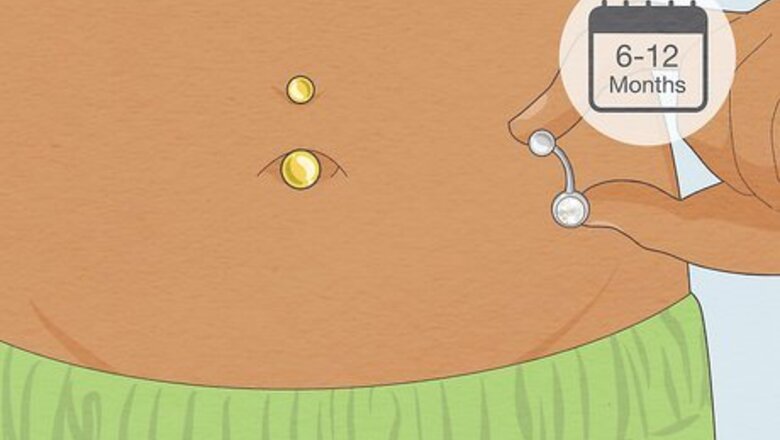
views
- Change your belly piercing once it’s healed, which normally takes around 6–12 months.
- Wait until your belly piercing is no longer swollen, red, painful, or leaking discharge to put in a new piece of jewelry.
- To change your belly piercing, wash your skin with a saline solution and unscrew the old jewelry. Gently pull the old jewelry out and slide the new jewelry in.
When can you change a belly piercing?
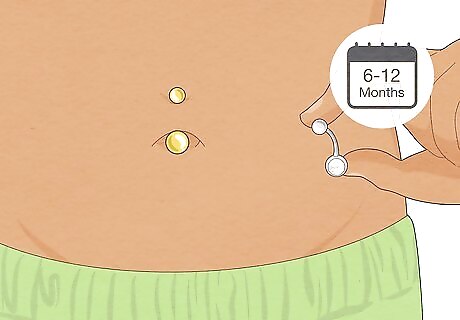
Wait 6–12 months for your belly piercing to heal before changing jewelry. When you first pierce your belly, it will be swollen and tender, so leave in the jewelry your piercer gives you. After 1 or 2 months, your belly piercing may look okay from the outside, but it’s still healing internally and could cause an infection if you try changing it. Leave the jewelry in for at least 6 months to be safe, but wait up to 1 year if you still feel tenderness around your belly button. Trying to change your piercing too early could prolong your healing time, cause more pain and irritation, or lead to infection. If an infection becomes severe, you may have to permanently take out your belly piercing. Since a navel piercing moves around any time you stretch or move your core, it takes a little longer to heal compared to other piercings. If your piercing hasn’t healed within 12 months, then visit your piercer so they can see if there are any issues prolonging your recovery.
Signs a Belly Piercing has Healed
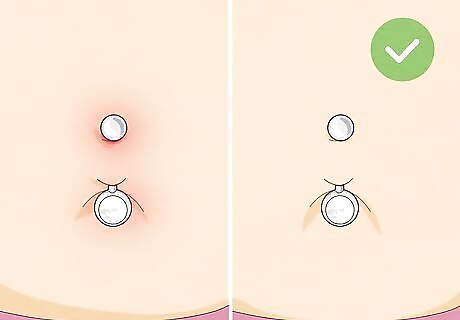
Your skin around the piercing is no longer red or swollen. It’s completely normal for your skin to swell or look red as your belly button piercing is healing. As you continue to recover, your skin will return to its normal color and the swelling will go down. Once the swelling and redness stay down for 2–3 weeks, it’s a good sign your piercing has healed completely. If you’ve taken anti-inflammatory medicine, like ibuprofen, it may also make your swelling go down. Wait until the medication wears off before checking the piercing site to determine if it’s healed or not.
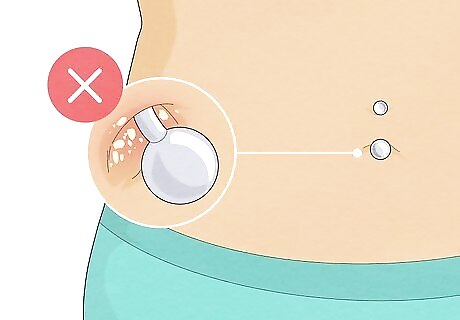
The area around the piercing site feels dry and crust-free. As your belly piercing heals, it may leak a clear discharge that has a crusty texture when it dries. Dab a clean paper towel onto your navel piercing and check if there are wet spots from any discharge. If you still see discharge forming, then let your piercing continue to heal. If the paper towel comes back dry, then you’re ready to change your jewelry. If the discharge looks white, yellow, or green, then it could be a sign of infection. If you notice your piercing looks infected, leave the jewelry in and contact your piercer to let them know your symptoms.
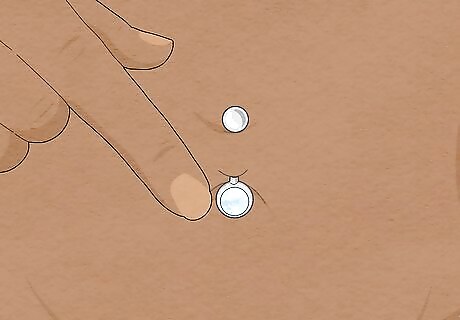
Your piercing feels painless whenever you touch it. As your skin heals, it will feel tender or painful any time you move or bump your piercing. As you’re taking care of your navel piercing, pay attention to how sensitive it is to light touches or movements. If your belly piercing is fully healed, it will move back and forth without any pain or irritation. Avoid playing with or forcing your piercing to move around since you could prolong your healing time. Only use a gentle touch to gauge whether it’s healed.
Changing a Belly Piercing
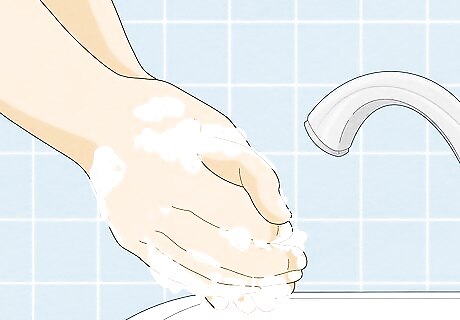
Wash your hands. Rinse your hands under warm water and lather them with fragrance-free antibacterial soap. Scrub your hands thoroughly to remove any dirt, oil, and bacteria so they don’t get into your belly piercing. Rinse and dry your hands thoroughly to remove all the residual suds. Avoid touching your piercing if you haven’t washed your hands since you could introduce bacteria to the inside of your piercing and cause an infection, even if it’s completely healed.
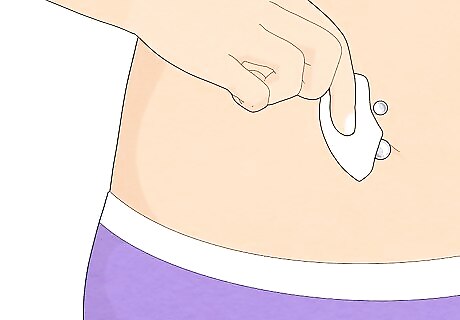
Clean the piercing site with a saline solution. Use a commercial solution, or make your own saline with ¼ teaspoon (6 g) of table salt with 1 ⁄2 fluid ounces (44 ml) of distilled water. Wet a gauze pad with the solution and hold it against your piercing to soften any discharge. Gently slide your belly piercing up and down so the solution gets inside. Cleaning your navel piercing ensures you don’t trap any bacteria when you put in your new jewelry.
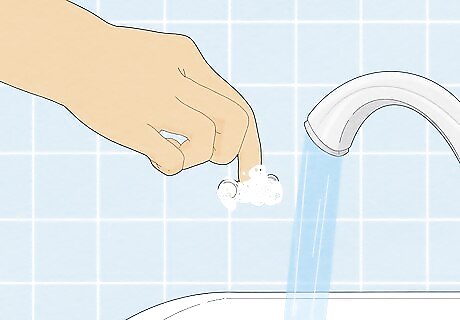
Wash your new piece of jewelry with antibacterial soap. Plug your sink so the jewelry doesn’t slip down the drain while you’re washing it. Take out your new belly button bar or ring out of the packaging and run it under warm water. Lather fragrance-free soap on your jewelry before rinsing it off with clean water. Then, just pat your jewelry dry with a paper towel. Stick with antegrade titanium or steel jewelry since it’s surgical-quality and least likely to cause irritation or an infection. If you choose gold jewelry, make sure it's 14 karats or higher so it doesn’t break down.

Unscrew your old belly piercing and slide the new one in. If you have a bar-shaped piece of jewelry, unscrew the top bead. If you have a ring, carefully push on the side of the bead to pop it out. Gently pull the old piece of jewelry through the piercing to remove it completely. Immediately slide the new piece of jewelry in through the bottom hole of the piercing, and attach the bead to hold it in place. If you feel any pain while you’re trying to remove the jewelry, stop right away since the piercing isn’t fully healed. Leave the jewelry in so you don’t cause any scars or infections. Put in new body jewelry as soon as you take the old one out. Your belly piercing may close up overnight and make it difficult or painful to reinsert new jewelry.
Belly Piercing Aftercare

Wash your belly piercing with saline solution twice a day. Clean your piercing every morning and evening. Wet a gauze pad with a commercial or homemade saline solution and hold it against your belly piercing. Let the saline solution soak into the piercing for about 3–5 minutes so it has time to soften any crusty discharge. Slowly move your piercing up and down in the hole to spread the solution, and pat it dry with a paper towel. If you don’t have saline solution, antibacterial soap makes a great alternative.
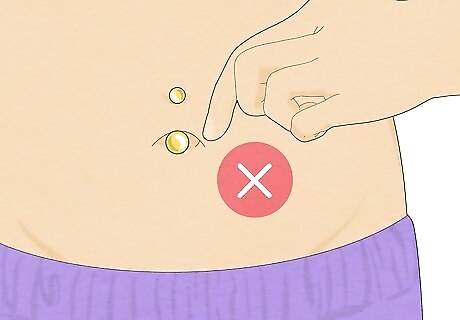
Touch your piercing as little as possible. Any time you bump or move your piercing while it’s healing, it has the potential to reopen the wounds on the inside and make your healing time longer. Try to only touch your piercing when you’re cleaning it to help reduce your recovery time. Touching your piercing could also transfer dirt and bacteria inside, which could potentially lead to an infection.

Wear loose-fitting clothing. Clothes like tight-fitting shirts, high-waisted jeans, and bodysuits, can all put pressure on your new piercing and cause it to move around. Instead, stick to clothes with a looser fit or crop tops that don’t brush up against your piercing to help it heal even faster. If you need to wear tighter clothes, secure a vented eye patch over your belly piercing to prevent irritation.
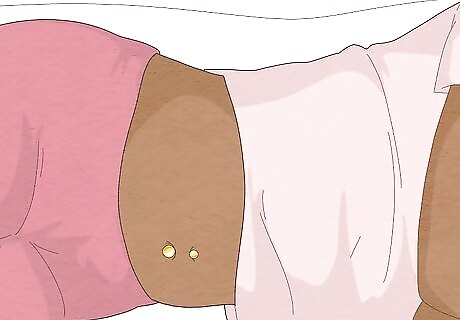
Sleep on your side or back. Laying on your stomach could pull or tug at your piercing, making it more painful and prolonging how long it takes to heal. Stop sleeping on your stomach and switch to lying on your side or back so you have a more comfortable night of sleep.
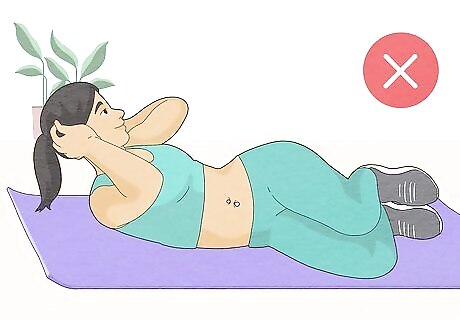
Stop doing strenuous core exercises. If you continue doing exercises like sit-ups, crunches, or intense yoga poses, your belly piercing may move around or put pressure against your skin and cause irritation. Stick to low-impact exercises that target other areas of your body so you’re less likely to cause damage to your piercing as it’s healing.

Avoid submerging your piercing in water while it’s healing. Since standing water is more likely to contain bacteria, stay out of swimming pools, lakes, rivers, oceans, or any other natural body of water. Rather than sitting in the bath, take a shower so the water runs off of the piercing right away. Wash your piercing with antibacterial soap or saline solution after you bathe to kill any bacteria on your skin.
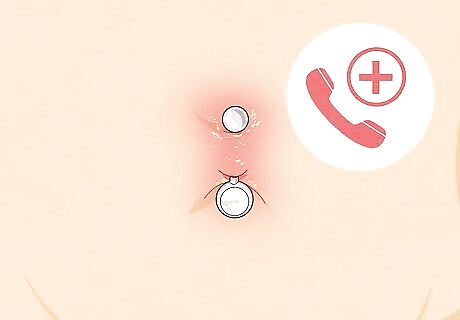
See a doctor if you notice signs of infection. As your piercing heals, watch for increased swelling, red lines forming around your belly button, and blood or pus leaking from the holes. Pay attention if you notice severe pain that doesn’t go away after 1–2 days or if your skin feels like it’s radiating heat around the piercing site. If you notice any of these symptoms, then contact your doctor so they can help treat the infection. Leave your jewelry in even if you think there’s an infection. Taking your jewelry out could trap bacteria inside the piercing. Your doctor may prescribe antibiotics or a medicated wash to help treat the infection. They may also recommend over-the-counter pain relievers to help with the irritation.




















Comments
0 comment